| Muscat, Oman, October
29 to November 1, 2011
By John Pint
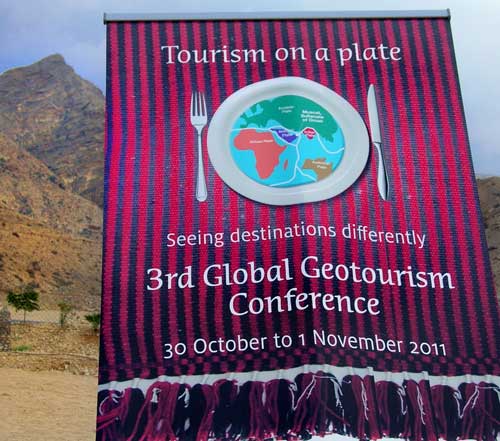 “Geoparks
are the fastest growing kind of parks in the world,” announced
Ross Dowling, coordinator of the third Global Conference on
Geotourism, held in Muscat, Oman last week, and yours truly was
there to cover the event, thanks to the generous sponsorship of
Jalisco Mexico’s Casa San Matías, distiller of Pueblo Viejo
tequila. “Geoparks
are the fastest growing kind of parks in the world,” announced
Ross Dowling, coordinator of the third Global Conference on
Geotourism, held in Muscat, Oman last week, and yours truly was
there to cover the event, thanks to the generous sponsorship of
Jalisco Mexico’s Casa San Matías, distiller of Pueblo Viejo
tequila.
To my surprise, I found I was representing, at this conference,
not only Jalisco and Mexico, but all the other countries of
Latin America as well, not to mention the rest of the
Spanish-speaking world. This is probably due to the fact that
Geotourism is something new in the field of tourism, as one
might guess from the fact that there is only one Geopark in all
of North America.
So, let’s take a look at what Geoparks and Geotourism are all
about. As Dowling explains it, tourism brings people into
contact with three marvelous worlds, which he sums up as A, B
and C: Abiotic, Biotic and Cultural. While B and C are usually
well attended to, the Abiotic world of rocks, magma, tectonic
plates and the great forces that formed our planet is often
understood only by geologists, but Dowling and other promoters
of Geotourism are out to change all that and to give the rest of
us a peek into the fascinating universe that literally lies
beneath our feet. As for Geoparks, they are sites featuring
geology which is rare or scientifically, aesthetically or
educationally interesting and they have been promoted by UNESCO
since 1999. It’s interesting to note that the very first
International Geoparks Conference took place in Beijing, China
in 2004. Today there are 87 officially recognized members of the
Global Geopark Network (GGN) in 27 countries, with most of these
parks in China, followed by Italy and Great Britain. Acceptance
by the GGN would give a park considerable prestige and I should
think would bring it visitors from all around the globe.
The conference was held at the lavish Muscat Hyatt Hotel which
served us up a great lunch every day out in their garden. The
Grand Banquet of the event, however, took place at the Bustan
Palace, which several people described as a “Seven-Star Hotel,”
more stars than I had ever heard of. This meal was served by an
army of white-gloved waiters and was so elegant that William and
Kate could have waltzed in the door and no one would have batted
an eye. By the way, the bill for all of this—plus the
participation fees and even the visas to Oman, were all absorbed
by the government, so let me say a big Shukran Jazilan (Muchas
Gracias) to his majesty Sultan Qaboos in the name of all the
Geotourism aficionados.
Guadalajara's Geodiversity
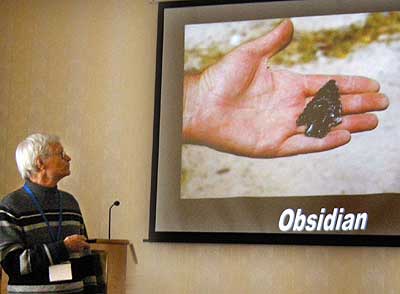 I
gave a talk at this conference on what I call The
Magic Circle around Guadalajara,
an area 500 kilometers wide encompassing portions of all five of
Mexico’s ecosystems and so much biodiversity and geodiversity
that you couldn’t possibly see all of its wonderful natural
sites in a single lifetime. Curiously, the world still hasn’t
discovered the Guadalajara area as a mecca for nature lovers,
although geologists tell me that their colleagues come to
western Mexico from all over the world just to look at sites
like Colima’s very active Fire Volcano, The Giant Pumice Horizon
(LINK), or Paricutín, in Michoacán, where a volcano popped up in
a cornfield in 1943, grew and then erupted, offering scientists
a rare opportunity to study various phenomena related to
volcanoes. I
gave a talk at this conference on what I call The
Magic Circle around Guadalajara,
an area 500 kilometers wide encompassing portions of all five of
Mexico’s ecosystems and so much biodiversity and geodiversity
that you couldn’t possibly see all of its wonderful natural
sites in a single lifetime. Curiously, the world still hasn’t
discovered the Guadalajara area as a mecca for nature lovers,
although geologists tell me that their colleagues come to
western Mexico from all over the world just to look at sites
like Colima’s very active Fire Volcano, The Giant Pumice Horizon
(LINK), or Paricutín, in Michoacán, where a volcano popped up in
a cornfield in 1943, grew and then erupted, offering scientists
a rare opportunity to study various phenomena related to
volcanoes.
27 Land Cruisers All in a Row
While numerous presenters in Muscat showed
beautiful slides of marvelous natural features, for me the
clearest example of what Geotourism really is, was our
experience during a field trip to a remote spot in Oman called
Wadi Mayh. This excursion took place in typical Omani fashion:
extravagantly. Four-wheel-drive vehicles were required for the
rough terrain we would visit, so the local sponsor of the
conference, His Majesty Sultan Qaboos himself, supplied 4WD
vehicles: Nearly 30 of them, in fact, and, of course all of them
brand-new, all of them Toyota Land Cruisers and all of them
white.
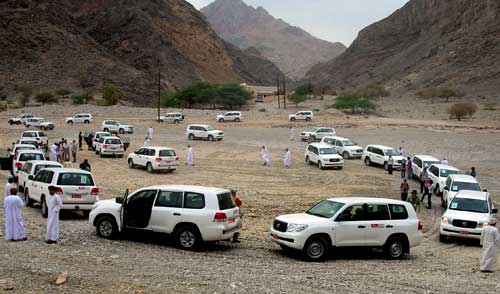 I
have never been in quite such a procession before and I am
amazed how smoothly the caravan threaded its way through narrow
mountain passes, wide expanses of loose gravel and down the kind
of steep dirt roads that leave your heart at the bottom of your
stomach. I
have never been in quite such a procession before and I am
amazed how smoothly the caravan threaded its way through narrow
mountain passes, wide expanses of loose gravel and down the kind
of steep dirt roads that leave your heart at the bottom of your
stomach.
Now, all this effort was aimed at bringing us face to face with
high cliff walls which a layman might hardly glance at while
driving by. Through megaphones, however, our guides pointed out
how the tectonic plates on or near which Oman sits, long ago
exerted tremendous pressure on the rock, pushing it upwards,
folding it over on itself and bringing a rare kind of rock
called ophiolite right up to the surface. Ophiolite is actually
part of the Earth’s upper mantle and oceanic crust and Oman is
widely considered to have some of the best exposed ophiolite in
the world. “We can see all this geology so easily here in Oman,”
explained our guides, “because the rock is completely exposed,
with scarcely any dirt or plant cover.”
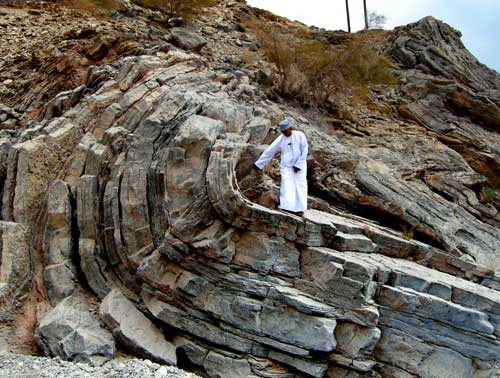 To
make the tour educational, the Omanis had prepared maps
indicating the geological attractions in the wadi and
demonstrated how a lone hiker or mountain biker could enjoy a
self-guided tour using a GPS-equipped iPad or other device to
inform him or her all about the local geology—a sort of robotic
cicerone, which I personally consider absurd due to the fact
that the screens on these devices are just about impossible to
see in bright sunlight, with which both Oman and Mexico have
been abundantly blessed. To
make the tour educational, the Omanis had prepared maps
indicating the geological attractions in the wadi and
demonstrated how a lone hiker or mountain biker could enjoy a
self-guided tour using a GPS-equipped iPad or other device to
inform him or her all about the local geology—a sort of robotic
cicerone, which I personally consider absurd due to the fact
that the screens on these devices are just about impossible to
see in bright sunlight, with which both Oman and Mexico have
been abundantly blessed.
What I learned on this field trip was that the presentation of
geological features can be made interesting to ordinary people,
but only up to a certain point. Many attendees agreed that this
kind of tour might be given a thumbs-up by people who are on
their way to or from some other truly remarkable tourist
attraction which might not necessarily be related to geology at
all, but if visitors are offered nothing but geology, they would
probably come away bored (sorry about that, geologist friends!).
A Geopark in Western Mexico?
This brought to mind the practical case of western Mexico,
which, at the moment, attracts tourists to sites like Lake
Chapala, Tequila and Tlaquepaque. There are, however, many
unusual geological features in the area and visits to some of
them could add new dimensions to a tourist’s visit to Jalisco.
I am thinking, for example, of Río Caliente,
Tequila Volcano, the Great Stone Balls (Piedras Bola), the
opal mines of Magdalena, the Giant Pumice Horizon of the
Primavera Forest, the
Fossil
Fumaroles of Tala and Jalisco’s vast
obsidian deposits which are
the third largest in the world. If this area—which I suggest
could be named “The Volcanic Geopark of Western Mexico”—were
accepted as a member of UNESCO’s Global Geopark Network, it
would become the second Geopark in North America and, of course,
the first in Mexico and would soon attract a new type of tourist
to this area, a tourist who might start out hiking through the
geologically rich deep canyons of the Primavera Forest and might
later enjoy the murals of Orozco, a visit to San Juan de Diós
Market and the charm of spending the night in a genuine
hacienda.
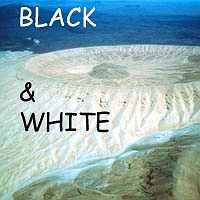 Likewise,
I can think of marvelous places in Saudi Arabia which could
easily merit Geopark status and could jumpstart the tourism
which that country has long wanted to initiate. There is, of
course, the vast Rub Al Khali Desert (LINK), but the most
dramatic Geotourism site would surely be the
Black and White Volcanoes of
Harrat Khaybar, all three of which are climbable without special
skills or equipment. These three volcanoes are located quite
near huge lava caves around three million years old (for example
Umm Jirsan Cave [LINK] as well as young caves with beautiful and
delicate formations. And on top of all that, Harrat Khaybar lava
field is full of Neolithic tombs and kites (stone-wall animal
traps), adding another attraction. Likewise,
I can think of marvelous places in Saudi Arabia which could
easily merit Geopark status and could jumpstart the tourism
which that country has long wanted to initiate. There is, of
course, the vast Rub Al Khali Desert (LINK), but the most
dramatic Geotourism site would surely be the
Black and White Volcanoes of
Harrat Khaybar, all three of which are climbable without special
skills or equipment. These three volcanoes are located quite
near huge lava caves around three million years old (for example
Umm Jirsan Cave [LINK] as well as young caves with beautiful and
delicate formations. And on top of all that, Harrat Khaybar lava
field is full of Neolithic tombs and kites (stone-wall animal
traps), adding another attraction.
Do Geoparks bring new revenue to a country? Well, Chinese
Geoparks report a 200% income increase since opening and their
latest Geopark in Hong Kong (These parks don’t necessarily have
to be out in the boonies if the geology is right) has already
had 1.5 million visitors since it opened and Ewan McCarthy of
Bright 3D in Scotland reported at the Geotourism conference that
nature-based tourism in his country has produced 17 billion
pounds in revenue and created jobs for 240,000 people .
According to Ross Dowling, this conference attracted over 400
people from 26 countries. “Compared to the previous conferences,
this was a lot bigger,” he commented. “Here in Oman there was
much more government involvement and a large number of students
attended, which was great. Oman didn’t know a lot about
Geotourism before, but now that they have been exposed to it, I
think they will get deeply involved. So the conference was very
successful, with a lot of really good outcomes.” Including, I
might add, possible good outcomes in Mexico, 15,000 kilometers
away.
Voyage to Oman’s Grand Canyon
The conference was over but Show-Cave expert Paolo Forti and I
had one extra day in Oman (a day neither of us will ever
forget!) which we had planned to spend at celebrated Al-Hoota
Cave which, we had heard, the Omani government had developed
sparing no expense. A tour company was to pick us up at 8:30 AM
and already at 6:00 AM a text message came beeping into my cell
phone: “Don’t forget your tour today: 8:30 Sharp!”
We cavers, of course, needed no reminding and at 8:30 we were
standing in the doorway ready to go, but instead of getting
picked up, we got a phone call: “I can’t find your address,
where are you?” Well, it took three more calls and directions
from three local people before our driver reached us, not a
favorable omen.
Our driver, however, turned out to be a jolly Omani named
Abdullah who spoke exceptionally good English. As we sped down
the highway heading south from Muscat, Abdullah confirmed the
positive assessment I had been hearing for days about the
country’s ruler, Sultan Qaboos. Among other things, he mentioned
that “Any person who wants to own land can get it from the
government for practically nothing, and if, after two years,
they want to sell it, they do so at a huge profit.”
After a couple hours we reached Nizwa, but instead of going to
the cave, Abdullah started up a road toward Jabal Shams, which
had been booked into our tour. Now Jabal (also spelled Jebel)
usually means “hill” in Arabic in the vaguest of senses. As the
winding road took us higher and higher, we realized Shams was
nothing less than a mountain. Soon the paved road became dirt
and when we reached 3000 meters, I felt like I was on top of an
Alpine peak, except for the 1500-year old boxlike houses we had
been passing on our way up.

Flooded wadi at the base of Jabal Al
Shams. Note the ancient houses in the distance (see close-up in
left column).
It was cold and there was a slight drizzle
as we stepped out of the Land Cruiser onto beautiful, nearly
black rock which looked like some kind of exquisite marble.
Paolo was ahead of me as we approached a steel railing off the
side of the road and suddenly I heard him gasp. So did I when I
reached him and beheld the awesome view. There was a drop of
1000 meters straight bellow us into an utterly spectacular
canyon entirely composed of that beautiful marble.
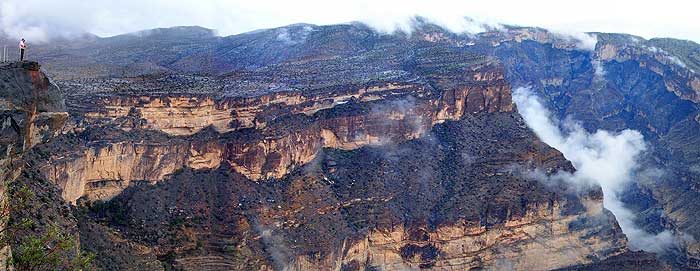
Prof. Paolo Forti looks out over magnificent Wadi Nakhr,
Oman's "Grand Canyon."
It was one of those views that takes your
breath away, but can’t possibly be done justice by a camera,
even with a fisheye lens. Maybe Imax might do the trick. This
seems to be Oman’s answer to the Grand Canyon and, in fact,
that’s just what they call it in Arabic. This was certainly the
kind of “major attraction” that a good Geopark would need to be
successful.
Murphy’s Law Even Works Underground
We then ate a delicious meal at an impeccably clean mountain
resort and headed back downhill. As we approached Al Hoota Cave,
there was a slight sprinkling of rain on the windshield. “Sorry,
Paolo,” I joked, “the cave is probably closed due to rain.”
Inside the visitor center, we were welcomed by a familiar face
we’d seen at the conference. “Ah, the speakers from Mexico and
Italy: marhabbah (welcome), but I have bad news: the cave is
closed due to rain!”
Paolo was in a state of shock and argued to no avail. It appears
to me that the company that undertook the Show Cave
transformation utterly failed to assess the cave’s function as a
drainage system for the nearby mountain range and had mis-designed
the cave tour. They should have used my group,
Desert
Caves Consultants, because only real cavers understand
caves.
In a blue funk, we headed back toward Muscat, stopping only for
an all-too-brief visit to 9th century Nizwa Fort which has a
gigantic cylindrical citadel famous for its “murder holes”
designed to drop invaders into deep chutes or scald them with
boiling date juice via hidden ceiling slots.
The light rain turned into a fierce squall as we continued along
the highway. “You are very fortunate,” said Abdullah. “You came
here to Oman to enjoy the desert and now you are seeing
something truly rare…it is raining in Oman! Alhamdullilah!”
I was reminded of the smiling faces of my students in Saudi
Arabia as they walked into the classroom soaked to the bone:
“Sir, sir, look, it is raining—how wonderful, Alhamdullilah!”
(Thank God, used even more often than Gracias a Diós in Mexico).
But we were less thankful when we ran into heavy traffic on the
outskirts of Muscat. “A wadi passes over the highway up ahead,”
said our driver. “Let’s hope the water is not too deep.” As we
had planes to catch later in the day, it was touch and go for a
while, but the Land Cruiser sailed right through the meter-deep
water.
We made it to the airport, alright, but I
would probably still be in Oman if I had not bumped into a kind
soul in the Departure Hall. In true Middle East fashion, this
room was jammed with 10,000 bodies, mostly package-laden people
trying to fly to India, and, of course, nobody standing in line.
Finding your check-in counter was simply impossible because
there was no way to walk up and down the huge hall looking for
the name of your airline. By good luck I met a young guy who had
seen KLM on the other side of the Great India-bound Horde and I
ended up flying out as planned. The only snag came when I
reached Los Angeles and discovered my one-hour layover was
actually a 12 hour layover, due to a little “pm” I hadn’t
spotted, allowing me plenty of time to search the departure
terminal for its one and only, well-hidden drinking fountain
(bubbler in Milwaukeeish). Since they were selling bottled water
there for up to $7.00 a liter (in the good old American
entrepreneurial tradition), this discovery saved me a fortune
during the long hours I had to force myself to stay awake,
waiting for my flight, whose gate number Aeromexico managed to
keep secret right up until boarding time.
After 40 very long hours of travel, even before landing at my
destination, I caught the familiar, unmistakable scent of the
Guadalajara airport (a unique combination of Eau de Sewage and
burning garbage, if you’ve never noticed)…but it was soooo nice
to be back!
By the way, the next Geotourism Conference will be held in
Iceland in 2013 and the following might be in Ecuador in 2015,
giving Mexico just enough time to set up North America’s second
Geopark.
|

